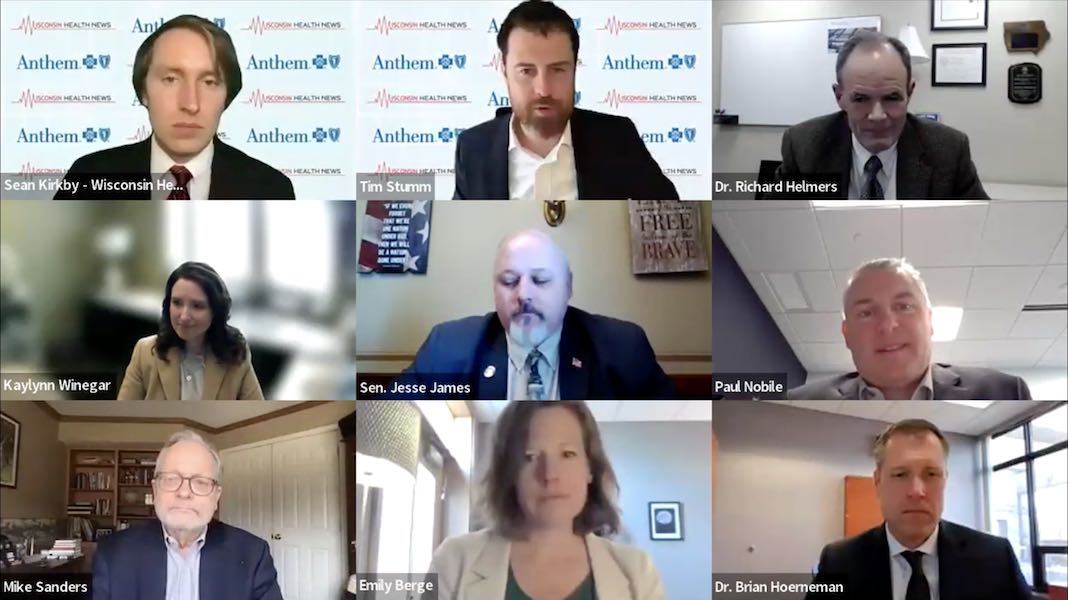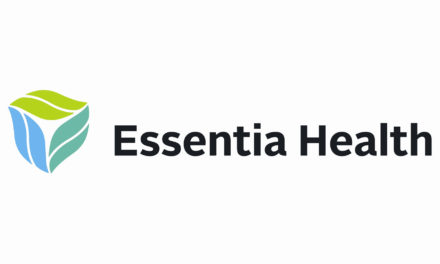
Western Wisconsin leaders respond to facility closures

Hospital Sisters Health System is closing its hospitals in Eau Claire and Chippewa Falls on Friday, and 19 Prevea Health clinics are shuttering in the coming months.
The closures, which were first announced two months ago, have shaken the region and left area providers and stakeholders racing to respond.
At a Wisconsin Health News virtual panel this week, experts discussed the impact, what’s next and the feasibility of a new hospital.
Panelists were:
- Emily Berge, President, Eau Claire City Council
- Dr. Richard Helmers, Regional Vice President, Mayo Clinic Health System in Northwest Wisconsin
- Dr. Brian Hoerneman, Interim CEO, Marshfield Clinic Health System
- Sen. Jesse James, R-Altoona
- Mike Sanders, Lead Advisor, Chippewa Valley Health Cooperative
- Kaylynn Winegar, Vice President of Investor Engagement, Eau Claire Area Chamber of Commerce
Edited excerpts are below.
Watch the event on WisconsinEye.
WHN: What’s the impact of these closures?
Berge: It’s a lot of grief and loss. A lot of anger in our community of how can this happen? … People found out that they’re going to lose their jobs in a couple months. People found out that they lost their providers … People are still reeling.
James: It’s obviously devastating to the entire region. There’s so many things that popped up when this occurred, things that typically you don’t think of until you hear it from the people. Like now Chippewa County doesn’t have a morgue. As a law enforcement officer, I don’t have the blood draw services available now. We’ll have to either go to Ladysmith or Eau Claire for a blood draw for an OWI arrest. You hear the impacts of Prevea urgent care centers (closing), and the medical directors are going to be gone. They’re the ones that prescribe medications to our adult living facilities scattered in the rural areas of the region … The list just goes on and on.
WHN: How are area providers preparing for an influx of emergency room patients?
Helmers: We were at capacity even before any of these closures occurred … Certainly, we’ve seen an increase in the number of patients coming to our emergency room and those that have serious issues, such as heart attacks and strokes and that sort of thing, we have accommodated … We are dealing with the increased volumes in the emergency room as best we can.
Hoerneman: Our ER in Eau Claire has been a combined ER/urgent care, and we’re doing a couple of things there to increase the capacity. We’re doing some facility changes there that will help improve our triage process as well as our fast track, so some of those patients who aren’t quite as sick can be moved through fairly quickly so people don’t have longer waits.
In Lake Hallie, we’ll be opening an urgent care to take some of that urgent care volume out of the emergency department. And, similar to what Dr. Helmers noted, (we’ll) have the emergency department be there for those very sick patients and for those who need it the most, and hopefully be able to then have that less acute patient, those who aren’t quite as sick, either be seen in urgent care or in primary care offices.
We’re also working with our primary care folks to increase the number of same-day access appointments that they have. We’re adding about 50 additional same-day access appointments in that same vein of trying to offload the emergency department as much as we can and prepare for that increase in patients.
WHN: How is the chamber of commerce responding?
Winegar: One of the very first committees we convened was on our patients’ needs and concerns. So what is the care that will be needed with these closures, and making sure that we can cover those, whether it’s existing business, new business that needs to come to the area or innovative approaches …
And then business effects. Is there new business that can come in that we can help streamline or take down any red tape for them to create care for those folks who need it? And of course, the jobs as well. We want to make sure that the trained healthcare professionals who exist in our community can stay here and that we can retain that talent because it’s desperately needed here.
WHN: How else are providers expanding services?
Sanders: We’re looking at a wide variety of options, like outpatient services to address the things that are most going to have an impact right away, like cancer care and cancer treatment. We know many patients are going to be traveling out of town. For therapy that sometimes is daily for eight weeks, that’s just really unacceptable for a community the size of Eau Claire and the Chippewa Valley.
We’re also looking at, long term, replacing inpatient hospital capacity. I appreciate the work that Marshfield and Mayo are doing to try to step up the volume in the ED and support the needs of the community. But the facts are, looking at numbers, it’s too many eggs to fit in the basket. We need to replace that capacity at some level.
Hoerneman: We’re expecting to be able to double or triple our capacity for seeing (obstetrics) patients. So we’ve got some facility changes. We should have things done in the next couple of weeks where we’ve been able to expand from eight to now 21 beds.
Helmers: In our northwest Wisconsin region, in addition to the hospital here in Eau Claire, we have our four critical access hospitals in Barron, Bloomer, Osseo and Menomonie. We really work as one hospital with five doors. So we have expanded the capacity in our critical access hospitals to accommodate an additional, approximately, 25 patients. We’ve increased the staffing capabilities at those critical access hospitals. We’ve also been working closely with our Mayo Clinic Health System colleagues in La Crosse. And they have accommodated patients from this area, both on an outpatient and inpatient basis, as they’ve had increased capabilities. And we do have our advanced care at home, or our home hospital program, that we have enhanced through this. And we have developed this primary care on demand, so that many patients are capable of getting primary care through the primary care on demand product that we have marketed in the Mayo Clinic Health System.
WHN: HSHS is closing two hospitals. Why would a new one fare better?
Sanders: I really can’t comment on HSHS. We tried to talk to them and try to get access to their numbers and data and see what trends are going on. They would have to speak for themselves on that.
My thought relative to that is based on the commitment and passion of the local leaders that are part of the (Chippewa Valley Health Cooperative); the commitment of the independent (OakLeaf Medical Network) physicians, which represent 35 to 40 percent of the patient population in terms of people they’re taking care of in their offices in primary care and, ultimately, specialty services; and input from many of the rural hospitals. I am very familiar with many of the rural hospital CEOs through my work with the Rural Wisconsin Health Cooperative when I was at Monroe Clinic. I know many of those people, and I’ve called many of them and talked to them. And they’re saying, ‘We need a place to transfer sick patients. We can’t get them in’ …
The short term things that Dr. Hoerneman and Dr. Helmers (are doing) will help, but they’re not permanent solutions. People from that region, there’s no need for them to go out of the area for services that the population base can support … As short as a year ago, 35 percent of the inpatient patients in that region were taken care of by the HSHS hospitals. One rural hospital I talked with, just in the last six weeks, saw an increase of 35 percent in OB, basically moms-to-be saying, ‘I’m going to come there.’ This is 100 new deliveries, which is a tremendous increase for a small hospital. And on one hand, they’re saying, ‘Well, we’ll do what we can with that.’ But these are people that are in the Eau Claire and Chippewa Valley area, who would have come to Sacred Heart and have chosen to go elsewhere, either because of capacity or personal decision, or whatever …
From an economic development perspective, I think of 1,400 jobs being lost. Some will be absorbed by my colleagues on the screen here, but all of them won’t. And I look at ourselves as a startup, originating out of the community, and saying, ‘We’re going to bring 500 to 600 to 700 of those jobs back, or retain them as a startup business, locally owned and operated.’ And I just think there’s a great opportunity for great success with that type of model.
Hoerneman: I don’t think we know the answer to that quite yet. And if the answer is yes, then I think the challenge is how to make that sustainable, and not have some of the same factors that were affecting HSHS lead to another hospital being stressed. Part of the issue with healthcare right now, as Mike was alluding to, is there’s a lot of factors out there that make healthcare not easy right now. There are many challenges stemming from reimbursement, which hasn’t kept up with inflation, particularly for those safety-net type hospitals, those that see patients that are coming in, regardless of their ability to pay, and are getting services, be it for mental health, be it for emergency department care. Those are expensive services to provide. And the cost to care for those patients is not fully reimbursed by the governmental payers, which largely those patients have. And so it’s a real challenge. And so that’s not an easy issue to address. Some of that can come through adjustment of state Medicaid rates and that sort of thing. But that takes time. It takes a lot of effort. And it’s expensive for the state as well. But I think that would be the key. We would have to figure out that sustainability piece, and really being part of that safety net for the community and being there for all patients.
Helmers: I don’t think we know yet. We need to decide and see what the long term impact of these closures are and what our colleagues at Marshfield and at OakLeaf and Mayo, what we can accommodate …
I would just echo the challenges that exist for all healthcare organizations. Challenges with workforce and challenges with reimbursement, and having financially sustainable decisions, those will be the challenges going forth as to how care is provided for all the citizens in Eau Claire.
This article first appeared in the Wisconsin Health News daily email newsletter. Sign up for your free trial here.





